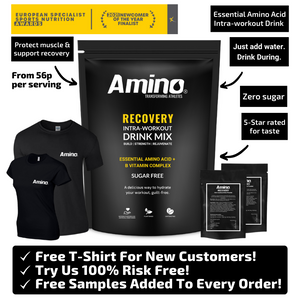Inflammation can be good or bad for our bodies and fitness goals. Read on to find out what exactly inflammation is and how you can combat it.

Inflammation is a natural part of our bodies’ complex defence mechanisms. It is activated when the body is infected, injured or diseased and it is designed to prevent damage from festering or spreading.
There are two key types of inflammation: acute and chronic. On a very simplistic level, these can be divided into ‘good’ and ‘bad’ inflammation respectively.
What is acute inflammation?
Acute inflammation can be prompted by the arrival of a virus or an injury, such as banging your elbow.
Your immune system will then react, pumping white blood cells to surround and protect the affected area. Depending on where the problem is, you could see the area turning red and becoming swollen. Your body will then work to remove the damaged cells and create new ones. During this time, you may lose some function and experience pain and heat in the area.
Acute inflammation is also triggered when you work out. This is because exercising causes micro tears in the muscle fibres, which your body must then repair.
Acute inflammation is seen as ‘good’ because it helps your body to repair itself. When training, acute inflammation can also help you to build up resistance to future injury. This is known as the ‘repeated bout effect’.
However, too much acute inflammation can be harmful. For instance, if you work out hard and do not give your body enough time to recover and reduce the inflammation, you can increase your risk of injury.
What is chronic inflammation?
Chronic inflammation is long-term inflammation and it can occur for reasons beyond being ill or injured. Prolonged stress has been linked to chronic inflammation, as has being overweight, smoking, and eating a diet high in trans fats, processed food and sugar.
This can lead to chronic inflammation symptoms such as:
- Pain
- Fatigue
- Depression and anxiety
- Gastrointestinal problems, such as Irritable Bowel Syndrome, constipation and diarrhoea
- More frequent infections
In the long-term, chronic inflammation can lead to serious diseases such as heart disease. It can also lead to issues with joint stability, resulting in long-term pain.

5 tips to combat inflammation
If you want to help your body combat ‘bad’ inflammation and prevent too much acute inflammation from occurring and leading to injury, take a look at these 5 top tips.
1. Rest and recover
When you exercise, you need to create just enough inflammation to trigger your body to repair itself and build back stronger. Alternating workouts so that different muscle groups are used will give your body time to repair your muscles. Complete rest between exercise can also be hugely beneficial.
READ MORE: The benefits of rest.
2. Exercise consistently
Sporadic workouts increase your risk of delayed onset muscle soreness (DOMS), which can inhibit your training and increase the risk of injury. Try to work out consistently so that you can benefit from the repeated bout effect and create the right level of inflammation to make your body stronger. Regular exercise will also help to keep your weight down, which will reduce your risk of chronic inflammation.
3. Combat stress
When you get stressed, your body can react in the same way as when it is ill or injured, creating inflammation. Managing and mitigating your stress is therefore important. Find out more about how you can support your body’s stress response.
4. Sleep better
Sleep is your body’s recovery period and not having enough of it can really hinder your body’s response to illness and injury. Try to get at least 8 hours of sleep every night to keep inflammation to a minimum.
5. Eat well
A healthy diet can help to reduce the possibility of bad inflammation. Opt for foods such as:
- Wholegrains
- Fatty fish (for plenty of Omega 3 fats)
- Broccoli
- Green tea
- Spices (turmeric, ginger and clove)
- Tomatoes
Getting plenty of amino acids to boost muscle protein synthesis will also help. Our Amino RECOVERY is a non-inflammatory source of essential amino acids (unlike whey) to help your body recover and get stronger. They’re also sugar-free and skip the artificial flavour of other supplements to reduce the risk of other inflammation.
RELATED: EAAs vs. Whey
ENJOYED THIS ARTICLE?
Sources
https://www.health.harvard.edu/heart-disease/ask-the-doctor-what-is-inflammation
https://www.healthline.com/health/inflammation
https://www.heartfoundation.org.nz/about-us/news/blogs/food-and-inflammation
https://www.metagenicsinstitute.com/blogs/inflammation-balanced/






